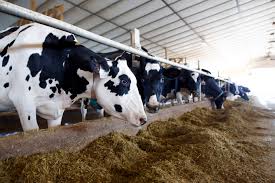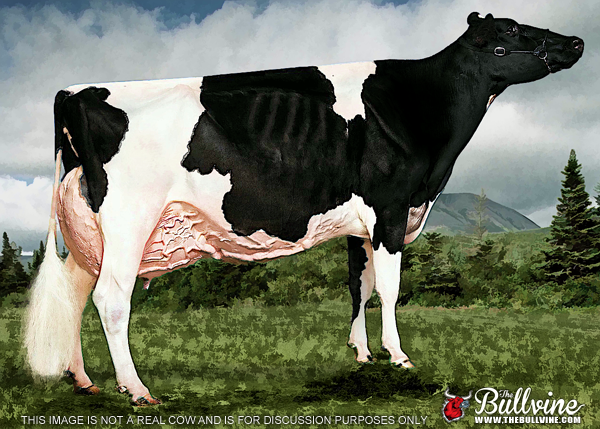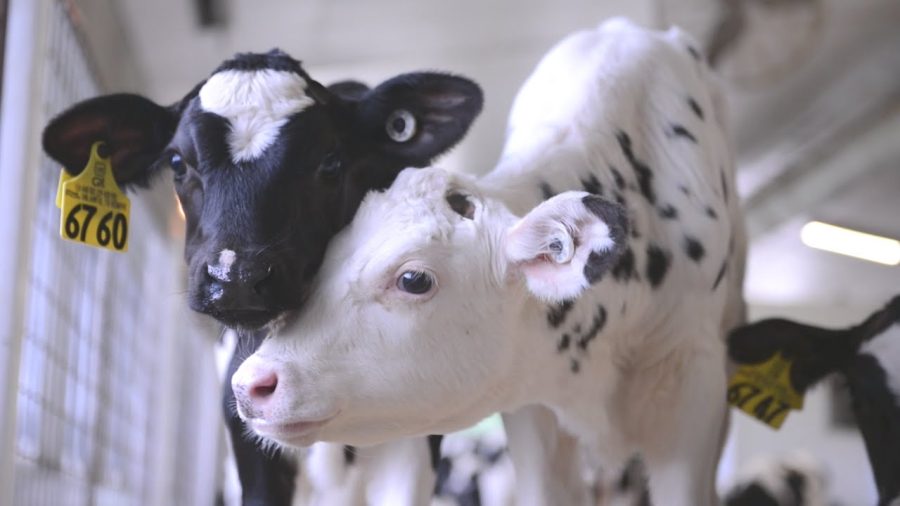Who gets to decide the future of dairy breeding? Understand the challenges and opportunities in shaping tomorrow’s selection programs.
Envision a future where dairy farming is revolutionized by precision and efficiency, with every cow’s genetic makeup optimized for maximum yield and health. This future, driven by the powerful genetic selection tool, has already begun to transform dairy breeding. It has doubled the rate of genetic improvements and refined valuable livestock traits. As we step into this scientific era, we must ponder: ‘What are we breeding for, and who truly makes these decisions?’ The answers to these questions hold the key to the future of dairy farming, influencing economic viability and ethical responsibility.
From Cows to Code: The Genetic Revolution in Dairy Breeding
Significant scientific breakthroughs and practical advancements have marked the evolution of dairy breeding programs, each contributing to the enhanced genetic potential of livestock populations. Initially, genetic selection laid the groundwork for these developments. Farmers and breeders relied heavily on observable traits such as milk production, fat content, and pedigree records to make informed breeding decisions. This form of traditional selective breeding focused on optimizing certain economic traits, primarily targeting yield improvements.
However, as scientific understanding evolved, so did the techniques used in breeding programs. The mid-to-late 20th century witnessed a pivotal shift with the introduction of computed selection indices. These indices allowed for a more refined approach by integrating multiple traits into a singular measure of breeding value. Yet, progress during this period was still relatively slow, constrained by the time-intensive nature of gathering and interpreting phenotypic data.
The transition to genomic selection marked a revolutionary phase in dairy breeding. By focusing on an animal’s DNA, breeders began to predict breeding values with greater precision and much faster. This leap was facilitated by advancements in genomic technologies, which allowed for the high-throughput sequencing of cattle genomes. Genomic selection bypassed many limitations of the traditional methods, significantly shortening the generation interval and doubling the rate of genetic gain in some livestock populations. As a result, dairy herds saw improvements not only in productivity but also in traits related to health, fertility, and longevity.
These advancements underscore the significant role that genetic and genomic selections have played in enhancing the quality and efficiency of dairy livestock. They have transformed breeding programs from artful practice to sophisticated science, propelling the industry forward and setting the stage for future innovations that promise even more significant gains.
The Power Players Behind Dairy Genetics: Steering the Future of American Dairy Farming
The intricate world of dairy farming in the United States is guided by several key participants who influence selection decisions and breeding objectives. At the forefront is the United States Department of Agriculture (USDA), with its Animal Genomics and Improvement Laboratory playing a pivotal role in crafting the indices that shape the future of dairy breeding. This laboratory collaborates with the Council on Dairy Cattle Breeding (CDCB), an essential body that operates the national genetic evaluation system and maintains a comprehensive cooperator database.
The CDCB’s board is a coalition of representatives from pivotal industry organizations, including the National Dairy Herd Information Association (NDHIA), Dairy Records Processing Centers, the National Association of Animal Breeders, and the Purebred Dairy Cattle Associations (PDCA). These institutions act as conduits for innovation and development in dairy cattle breeding through their valuable input in developing selection criteria and objectives.
Breeding companies, notably ST, GENEX, and Zoetis, bring a competitive spirit. They publish their indices incorporating standard CDCB evaluations and proprietary traits. Their role extends beyond mere evaluation to actively shaping market demand with innovative selection tools that sometimes lack transparent review, raising questions about their added value or potential marketing motives.
Dairy farmers, the end-users of these breeding advancements, wield significant influence over these indices through their adoption—or rejection—of the tools. Their perception of the indices’ value, informed by their unique economic and operational environments, can drive the evolution of these tools. While some may adhere to national indices like the net merit dollars (NM$), others might opt for customized solutions that align with their specific production goals, reflecting the diversity within the dairy farming community and their crucial role in shaping the future of dairy breeding.
Together, these stakeholders form a dynamic network that drives the continual advancement of breeding programs, adapting them to meet modern demands and improving the genetic quality of dairy herds nationwide. Their collaboration ensures that long-standing traditions and innovative advancements shape the future of dairy genetics, making each stakeholder an integral part of this dynamic process.
The Tug of War in Dairy Genetic Selection: Balancing Economics, Environment, and Innovation
Updating selection indices, like the Net Merit Dollars (NM$) index, involves complexities beyond simple calculations. Each trait within an index holds a specific weight, reflecting its importance based on economic returns and genetic potential. Deciding which traits to include or exclude is a hotbed of debate. Stakeholders ranging from geneticists to dairy farmers must reach a consensus, a task that is far from straightforward. This process involves diverse objectives and perspectives, leading to a challenging consensus-building exercise.
The economic environment, which can shift abruptly due to fluctuations in market demand or feed costs, directly influences these decisions. Such economic changes can alter the perceived value of traits overnight. For instance, a sudden rise in feed costs might elevate the importance of feed efficiency traits, prompting a reevaluation of their weights in the index. Similarly, environmental factors, including climate-related challenges, dictate the emergence of traits like heat stress tolerance, pressing stakeholders to reconsider their traditional standings in the selection hierarchy.
The dynamism of genetic advancement and external pressures necessitates frequent reevaluation of indices. Yet, every update involves complex predictions about future conditions and requires balancing between immediate industry needs and long-term genetic improvement goals. As these factors interplay, the task remains a deliberate dance of negotiation, scientific inquiry, and prediction that continuously tests the resilience and adaptability of dairy breeding programs.
Tech-Driven Transformation: From Traditional Farms to Smart Dairies
In the ever-evolving landscape of dairy farming, integrating new technologies holds immense potential to revolutionize data collection and utilization in selection decisions. Sensor-based systems and high-throughput phenotyping are two frontrunners in this technological race. They promise enhanced accuracy and real-time insights that could significantly improve breeding programs, sparking excitement about the future of dairy farming.
Sensor-based systems are beginning to permeate dairy operations, continuously monitoring farm environments and individual animal health metrics. These technologies enable farmers to gather rich datasets on parameters such as feed intake, movement patterns, and milk composition without constant human supervision. Such detailed information provides a clearer picture of each cow’s performance, which is invaluable for making informed selection and breeding decisions. Real-time data collection means potential issues can be identified and addressed swiftly, potentially reducing health costs and improving overall herd productivity.
High-throughput phenotyping, on the other hand, expands on traditional methods by allowing the measurement of multiple traits via automated systems. This technology can swiftly and efficiently capture phenotypic data, offering scientists and breeders a broader set of traits to evaluate genetic merit. The scale at which data can be collected through high-throughput phenotyping allows for a more comprehensive understanding of genetic influences on various performance traits, supporting the development of more robust selection indices.
However, these technologies’ promise comes with challenges. A significant hurdle is the need for more standardization. With numerous proprietary data systems, standardized protocols are urgently needed to ensure data consistency across different systems and farms. Without standardization, data reliability for genetic evaluations remains questionable, potentially undermining the precision of selection decisions.
Validation is another critical challenge that must be addressed. As innovations continue to emerge, the assumptions upon which they operate need rigorous scientific validation. This ensures that the data collected genuinely reflects biological realities and provides a solid foundation for decision-making. The risk of basing selections on inaccurate or misleading data remains high without validation.
Furthermore, seamless data integration into existing genetic evaluation systems is not enough. The current infrastructure must evolve to accommodate new data streams effectively. This might involve developing new software tools or altering existing frameworks to handle data’s increased volume and complexity. Ensuring seamless integration requires collaboration across sectors, from tech developers to dairy farmers. It fosters an environment where data can flow unimpeded and be put to its best use.
Embracing these technologies with careful attention to their associated challenges can lead to significant advancements in dairy breeding programs. By harnessing the power of cutting-edge technology while addressing standardization, validation, and integration issues, the industry can move towards more precise, efficient, and sustainable selection decisions.
Preserving Genetic Diversity: The Unsung Hero in Sustainable Dairy Breeding
One of the critical concerns surrounding dairy cattle breeding today is the potential reduction in genetic diversity that can arise from intense selection pressures and the widespread use of selection indices. The drive to optimize specific traits, such as milk production efficiency or disease resistance, through these indices can inadvertently narrow the genetic pool. This is mainly due to the focus on a limited number of high-performing genotypes, often resulting in the overuse of popular sires with optimal index scores.
The genetic narrowing risks compromising the long-term resilience and adaptability of cattle populations. When selection is heavily concentrated on specific traits, it may inadvertently cause a decline in genetic variability, reducing the breed’s ability to adapt to changing environments or emerging health threats. Such a focus can lead to inbreeding, where genetic diversity diminishes, leading to potential increases in health issues or reduced fertility, further complicating breeding programs.
Despite these concerns, strategies can be employed to maintain genetic diversity while still achieving genetic gains. These strategies involve a balanced approach to selection:
- Diverse Breeding Strategies: Breeders can implement selection methods emphasizing a broader set of traits rather than just a few high-value characteristics, thus ensuring a diverse gene pool.
- Use of Genetic Tools: Tools such as genomic selection can be optimized to assess the genetic diversity of potential breeding candidates, discouraging over-reliance on a narrow genetic group.
- Rotational Breeding Programs: Introducing rotational or cross-breeding programs can enhance genetic diversity by utilizing diverse genetic lines in the breeding process.
- Conservation Initiatives: Establishing gene banks and conducting regular assessments of genetic diversity within breeding populations can help conserve genetic material that may be useful in the future.
- Regulatory Oversight: National breeding programs could enforce guidelines that limit the genetic concentration from a few sires, promoting a more even distribution of genetic material.
By implementing these strategies, dairy breeders can work towards a robust genetic framework that supports the immediate economic needs and future adaptability of dairy cattle. This careful management ensures the industry’s sustainability and resilience, safeguarding against the risks posed by genetic uniformity.
The New Frontiers of Dairy Genetics: Embracing Complexity for a Sustainable Future
The landscape of genetic selection in the U.S. dairy sector is poised for significant transformation, steered by technological advancements and evolving farm needs. The future promises an expanded repertoire of traits in selection indices, acknowledging both the economic and environmental challenges of modern dairy farming. The potential inclusion of traits like feed efficiency, resilience to environmental stresses, and even novel health traits will cater to the increasing need for sustainable production practices. While these additions enhance the genetic toolbox, they complicate decision-making due to potential trade-offs between trait reliability and economic impact.
Moreover, the possibility of breed-specific indices looms large on the horizon. A one-size-fits-all approach becomes increasingly untenable, with varying traits prioritized differently across breeds. Breed-specific indices could provide a more refined picture, allowing for optimized selection that respects each breed’s unique strengths and production environments. While technically challenging, this shift could catalyze more precise breeding strategies, maximizing genetic gains across diverse farming operations.
Concurrently, the emergence of customized indices tailored to individual farm demands offers a promising avenue for personalized breeding decisions. As farms vary in size, management style, and market focus, a bespoke approach to selection indices would allow producers to align genetic goals with their specific operational and economic contexts. This customization empowers farmers by integrating their unique priorities—whether enhanced milk production, improved animal health, or efficiency gains—within a genetic framework that reflects their singular needs.
In sum, the future of U.S. selection indices in the dairy industry will likely include a blend of broader trait inclusion, breed-specific customization, and farm-tailored solutions. These adaptations promise to enhance genetic selection’s precision, relevance, and impact, supporting a robust and sustainable dairy sector that meets tomorrow’s dynamic challenges.
Melding Milk and Mother Nature: The Crucial Role of Environment in Dairy Genetics
The landscape of dairy breeding is shifting as the need to incorporate environmental effects into genetic evaluations becomes increasingly apparent. In a rapidly evolving agricultural world, factors affecting performance are not solely genetic. The environment is crucial in shaping breeding programs’ potential and outcomes. This understanding opens new avenues for enhancing selection accuracy and ensuring sustainable dairy farming.
By considering environmental effects, farmers can gain a more holistic view of how their cows might perform under specific farm conditions. These effects, divided into permanent aspects like geographic location and variable ones such as seasonal changes in feed, help build a comprehensive picture of dairy cow potential. Recognizing that genotype-by-environment interactions can influence traits as much as genetic merit alone allows farmers to tailor breeding strategies to their unique settings.
The quest to decode these interactions holds promise. As sensors and data collection technologies develop, capturing detailed environmental data becomes feasible. Feeding regimens, housing conditions, and health interventions can be factored into genetic predictions. Such precision in understanding the cow’s interactions with its environment enhances selection accuracy. It can lead to meaningful improvements in health, productivity, and efficiency.
Moreover, acknowledging these interactions fosters a breeding philosophy sensitive to productivity and sustainability. It supports resilience against climate challenges and encourages practices that align with environmental goals. Ultimately, incorporating this dual focus of genetics and environment in dairy breeding could be the key to a future where dairy farming meets both economic demands and ecological responsibilities.
Data: The Lifeblood of Dairy Genetic Progress
The flow and integrity of data play a pivotal role in shaping the future of genetic evaluations in the intricate tapestry of dairy breeding. Managing and integrating diverse data sources to create a unified, reliable system offers immense opportunities.
Firstly, with the advent of sensor-based and innovative farming technologies, data influx has increased exponentially. These technologies promise to harness real-time data, providing an unprecedented view of animal genetics and farm operations. The potential to improve breeding precision, optimize feed efficiency, and enhance animal health through this data is vast. By tapping into this reservoir of information, farmers and researchers can develop more effective breeding strategies that account for genetic potential and environmental variables.
However, with these opportunities come significant challenges. Key among these is data ownership. Many modern systems store data in proprietary formats, creating data silos and raising questions about who truly owns the data generated on farms. This lack of clarity can lead to data access and use restrictions, which inhibits collaborative research and development efforts. Ensuring farmers have autonomy over their data while respecting the proprietary technologies in use is a delicate balancing act.
Quality certification also poses a substantial challenge. Unlike traditional data sources with established protocols, many newer technologies operate without standardized validation. This lack of certification can lead to consistency in data quality, making it difficult to ensure accuracy across large, integrated datasets. Organizations like the NDHIA in the United States serve as gatekeepers, ensuring lab measurements are precise and calculations correct, but expanding such oversight to new technologies remains a hurdle.
National databases are indispensable in supporting genetic evaluations. They act as centralized repositories of validated data, facilitating comprehensive analyses that underpin genetic improvement programs. These databases must be continually updated to incorporate new data types and technologies. They also need robust governance structures to manage data contributions from multiple sources while ensuring privacy and security.
In conclusion, while considerable opportunities exist to leverage diverse data sources for dairy breeding advancements, addressing ownership dilemmas, achieving data certification, and reinforcing national databases are crucial. These efforts will ensure that genetic evaluations remain reliable, actionable, and beneficial to all stakeholders in the dairy industry.
The Bottom Line
The future of dairy breeding hinges on integrating complex genetic advancements with traditional agricultural wisdom while balancing the economic, environmental, and technological facets that define modern farming. Throughout this examination, we have delved into the mechanisms and challenges underscoring today’s breeding programs—from the evolving role of selection indices to the adoption of technology-driven phenotyping and the delicate dance of maintaining genetic diversity. At the core of these endeavors lies a critical need for a cohesive strategy—one where dairy farmers, scientists, commercial entities, and regulatory bodies work hand in hand to forge paths that benefit the entire industry.
As we reflect on the pressing themes of accountability, innovation, and sustainability, it becomes evident that genetic evaluations should support individual farms and act as a shared resource, accessible and beneficial to all. Readers are encouraged to ponder the far-reaching consequences of breeding choices, recognizing that while genetics offers unprecedented tools for enhancement, it also demands responsible stewardship. Ultimately, our collective success will be determined by our ability to harmonize data, technology, and practical farming experience, ensuring a prosperous and sustainable future for dairy farming worldwide.
Summary:
The dairy industry is on the brink of a technological revolution, with genetic advancements and technological integration becoming pivotal in shaping the future of selection decisions and breeding programs. These changes are driven by complex factors such as economics, genetic diversity, and environmental impacts. Key players, like the USDA and companies such as Zoetis, are steering these advancements, with breeding companies like ST and Zoetis publishing indices that dairy farmers influence through their adoption or rejection. The process involves updating indices to reflect traits’ economic returns and genetic potential, influenced by market demands, feed costs, and environmental challenges like heat stress. As genetic advancements accelerate, frequently reevaluating these indices becomes necessary, balancing short-term needs with long-term genetic goals. Innovative technologies, such as sensor-based systems, offer transformative potential for data collection, enhancing decision-making in dairy genetics.
Key Takeaways:
- The evolution of selection indices in the dairy industry highlights a shift from focusing solely on yield traits to incorporating health, fertility, and sustainability.
- Technological advancements like sensor-based systems enable continuous data collection on farm environments and animal performance.
- There is an ongoing debate about the role of commercial indices and proprietary tools versus traditional selection indices, emphasizing transparency and validation.
- Increased trait complexity requires indices to potentially break down into subindices, allowing farmers to focus on particular areas of interest like health or productivity.
- Breeders face pressures related to maintaining genetic diversity within the Holstein breed amidst rapid gains in genetic selection.
- Future indices must adapt to account for differing needs across breeds and individual farm operations, moving towards customized, farm-specific solutions.
- The dairy industry’s success hinges on treating genetic evaluations as a collective resource while accommodating individual farmer choices.
- Expansion in data sources poses challenges regarding standardization, certification, and ownership, necessitating robust frameworks for data integration and use.
Learn more:
- 5 Things You MUST Know about the Future of the Dairy Breeding Industry
- Genomic Selection: Doubling of the Rate of Genetic Gain in the US Dairy Industry
- Who Controls The Future of The Dairy Breeding Industry?
 Join the Revolution!
Join the Revolution!
Bullvine Daily is your essential e-zine for staying ahead in the dairy industry. With over 30,000 subscribers, we bring you the week’s top news, helping you manage tasks efficiently. Stay informed about milk production, tech adoption, and more, so you can concentrate on your dairy operations.







 Join the Revolution!
Join the Revolution!










